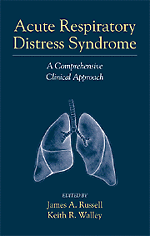Book contents
- Frontmatter
- Contributors
- Contents
- Preface
- Introduction
- 1 Overview, Clinical Evaluation, and Chest Radiology of ARDS
- 2 The Epidemiology of ARDS
- 3 The Pathology of ARDS
- 4 Cytokine -Induced Mechanisms of Acute Lung Injury Leading to ARDS
- 5 Pulmonary Pathophysiohgy in ARDS
- 6 Cardiovascular Management of ARDS
- 7 Mechanical Ventilation
- 8 Respiratory Muscles and Liberation from Mechanical Ventilation
- 9 Clinical Assessment and Total Patient Care
- 10 ARDS: Innovative Therapy
- 11 Nosocomial Pneumonia in ARDS
- 12 Resolution and Repair of Acute Lung Injury
- 13 Multiple System Organ Failure
- 14 Outcome and Long-Term Care of ARDS
- Index
7 - Mechanical Ventilation
Published online by Cambridge University Press: 05 October 2010
- Frontmatter
- Contributors
- Contents
- Preface
- Introduction
- 1 Overview, Clinical Evaluation, and Chest Radiology of ARDS
- 2 The Epidemiology of ARDS
- 3 The Pathology of ARDS
- 4 Cytokine -Induced Mechanisms of Acute Lung Injury Leading to ARDS
- 5 Pulmonary Pathophysiohgy in ARDS
- 6 Cardiovascular Management of ARDS
- 7 Mechanical Ventilation
- 8 Respiratory Muscles and Liberation from Mechanical Ventilation
- 9 Clinical Assessment and Total Patient Care
- 10 ARDS: Innovative Therapy
- 11 Nosocomial Pneumonia in ARDS
- 12 Resolution and Repair of Acute Lung Injury
- 13 Multiple System Organ Failure
- 14 Outcome and Long-Term Care of ARDS
- Index
Summary
Introduction
In many patients mechanical ventilation simply supports tidal breathing, for example, patients under general anesthesia or patients with trauma, drug overdose, sepsis, shock, or COPD. However, in ARDS patients, appropriate adjustment of mechanical ventilation may sometimes choose to support tidal breathing inadequately (permissive hypercapnia) to achieve more important goals. Mechanical ventilation of ARDS patients is complex and requires consideration of underlying pulmonary and cardiovascular physiology (Chapters 5 and 6), oxygen transport, beneficial and detrimental effects of positive pressure ventilation, the time course of airway pressure changes (e.g., assist-control mode vs. pressure control or other modes), cardiopulmonary interaction, and the effect of other nonpulmonary therapies (e.g., diuresis, inotropes). In this chapter the issue of mechanical ventilation of ARDS patients is approached from the perspective of the clinician – stepwise from the beginning. Issues that must be addressed in all patients, such as tidal volume, PEER and ventilator mode, are addressed first. This is then followed by “what if.” What if hypoxemia is still a problem? What if hypotension is a problem? Finally, important complications of mechanical ventilation are addressed.
Initiating Mechanical Ventilation
In patients with significant ARDS, one of two fundamental derangements typically leads the intensivist to begin mechanical ventilation: either hypoxemia no longer responds to oxygen (due to intrapulmonary shunt) or the work of breathing becomes excessive and unsustainable (due to reduced lung compliance, often compounded by a high minute ventilation). A subset of patients may be candidates for noninvasive ventilation, described later. Most will require endotracheal intubation (see Table 7.1).
- Type
- Chapter
- Information
- Acute Respiratory Distress SyndromeA Comprehensive Clinical Approach, pp. 139 - 162Publisher: Cambridge University PressPrint publication year: 1999
- 1
- Cited by



